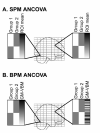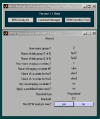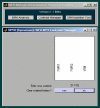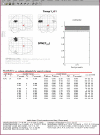Biological parametric mapping: A statistical toolbox for multimodality brain image analysis
- PMID: 17070709
- PMCID: PMC1994117
- DOI: 10.1016/j.neuroimage.2006.09.011
Biological parametric mapping: A statistical toolbox for multimodality brain image analysis
Abstract
In recent years, multiple brain MR imaging modalities have emerged; however, analysis methodologies have mainly remained modality-specific. In addition, when comparing across imaging modalities, most researchers have been forced to rely on simple region-of-interest type analyses, which do not allow the voxel-by-voxel comparisons necessary to answer more sophisticated neuroscience questions. To overcome these limitations, we developed a toolbox for multimodal image analysis called biological parametric mapping (BPM), based on a voxel-wise use of the general linear model. The BPM toolbox incorporates information obtained from other modalities as regressors in a voxel-wise analysis, thereby permitting investigation of more sophisticated hypotheses. The BPM toolbox has been developed in Matlab with a user-friendly interface for performing analyses, including voxel-wise multimodal correlation, ANCOVA, and multiple regression. It has a high degree of integration with the SPM (statistical parametric mapping) software relying on it for visualization and statistical inference. Furthermore, statistical inference for a correlation field, rather than a widely used T-field, has been implemented in the correlation analysis for more accurate results. An example with in vivo data is presented, demonstrating the potential of the BPM methodology as a tool for multimodal image analysis.
Figures





References
-
- Ashburner J, Friston KJ. Voxel-based morphometry-the methods. Neuroimage. 2000;11:805–821. - PubMed
-
- Automotive Industry Task Force (AIAG) Measurement Systems Analysis Reference Manual. Chrysler, Ford, General Motors Supplier Quality Requirements Task Force; 1994.
-
- Benjamini Y, Hochberg Y. Controlling the False Discovery Rate: A Practical and Powerful Approach to Multiple Testing. Journal of the Royal Statistical Society. 1995;57(1):289–300.
-
- Cao J, Worsley KJ. The Geometry of Correlation Fields with an Application to Functional Connectivity of the Brain. Annals of Applied Probability. 1999;9:1021–1057.
Publication types
MeSH terms
Grants and funding
LinkOut - more resources
Full Text Sources

